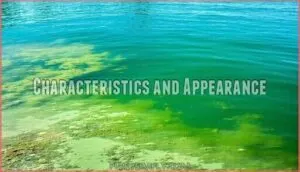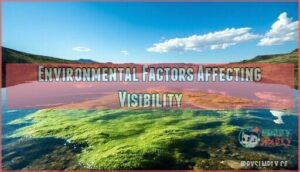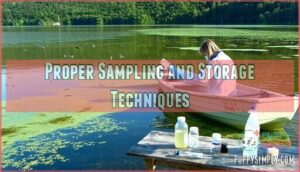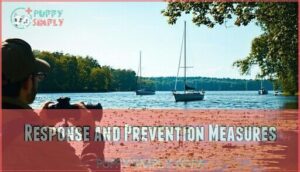This site is supported by our readers. We may earn a commission, at no cost to you, if you purchase through links.

Look for thick, scummy mats with a blue-green, red, or brown color floating on water surfaces.
These blooms often smell musty or fishy – like that forgotten gym bag in your car trunk.
The water may appear painted or have an oily sheen.
While these field tests help spot potential cyanobacteria, they can’t confirm toxicity levels.
Professional lab testing remains essential for definitive identification since some harmless algae mimic dangerous blooms.
Simple observation techniques can reveal telltale signs that separate toxic blooms from their innocent cousins, helping to identify toxicity levels.
Table Of Contents
- Key Takeaways
- Lab Confirmation Importance
- Identifying Blue Green Algae
- Safety Precautions and Handling
- Response and Prevention Measures
- Frequently Asked Questions (FAQs)
- How can you test for blue-green algae?
- How long does it take to test for blue-green algae?
- How do I know if it is blue-green algae?
- How long do cyanobacteria blooms typically last?
- What water temperature threshold triggers cyanobacteria growth?
- Are home test kits accurate for detection?
- Can pets recover from cyanobacteria toxin poisoning?
- Conclusion
Key Takeaways
- You can spot potential blue-green algae by looking for paint-like scum, blue-green coloring, and musty odors, but these visual clues can’t confirm if the bloom’s actually toxic.
- Don’t trust DIY tests alone—you’ll need professional lab analysis to determine actual toxin levels since harmless algae often look identical to dangerous cyanobacteria.
- Stay away from suspected blooms completely until testing confirms safety—keep yourself, kids, and pets out of discolored water since toxins can cause serious health problems.
- Prevent future blooms by reducing nutrient pollution through phosphate-free fertilizers, proper septic maintenance, and shoreline buffers that stop runoff from reaching water sources.
Lab Confirmation Importance
While DIY tests can point you toward blue-green algae, they won’t give you the whole picture.
DIY tests give you clues, but labs reveal the real danger.
Visual identification and simple field tests might suggest cyanobacteria presence, but they can’t confirm toxicity levels or determine if water samples contain harmful hepatotoxins.
Lab testing remains your most reliable confirmation procedure for identifying toxic blooms.
Professional diagnostic tools use immunocomplex assay methods to detect specific toxins in water samples.
These rapid diagnostic tools can identify eleven common hepatotoxins with sensitivity below 1 part per billion.
While newer field kits provide results in 40 minutes, they still can’t guarantee water safety without proper lab confirmation.
Think of DIY tests as your first line of defense—useful screening tools that help you decide whether professional testing is necessary.
When harmful algal blooms threaten public health, accurate toxicity assessment through laboratory analysis becomes essential for making informed safety decisions.
Understanding allergy test kits can also provide insights into the importance of precise diagnostic methods in various fields.
Identifying Blue Green Algae
You can identify blue-green algae through simple visual tests and environmental observations that help distinguish it from harmless plant matter.
These field identification methods provide quick initial assessment, though they aren’t foolproof and require careful interpretation.
You can use these methods to make a distinction, and they are helpful for a quick initial assessment.
Characteristics and Appearance
Blue green algae creates unmistakable visual clues when blooming in water bodies.
You’ll spot these harmful algal blooms by their distinctive paint-like or pea soup appearance that sets them apart from typical algae types.
Key visual indicators include:
- Paint or pea soup consistency floating on water surfaces
- Green to blue-green color variations (occasionally other hues)
- Surface scum formation along shorelines and open water
- Small particles or patches rather than stringy strands
- Bloom patterns that shift with wind and water currents
These bluegreen algae characteristics help with algae identification, though visual indicators alone aren’t foolproof for algae bloom identification.
Differentiation From Other Algae
Looking beyond surface appearance, you’ll need specific testing methods to distinguish cyanobacteria from other algae types.
Filamentous algae forms hair-like strands, while blue green algae creates paint-like coatings on sticks.
Laboratory water testing identifies unique pigments like phycocyanin in cyanobacteria.
Proper algae identification requires understanding these bloom characteristics and algal classification differences for accurate species determination.
The unique genetic traits of certain breeds, such as the blue poodle genetics, can inform our understanding of how specific characteristics are inherited and expressed in various organisms, involving complete concepts and accurate species determination with proper algae identification.
Environmental Factors Affecting Visibility
Wind patterns and water currents act like invisible conductors, orchestrating where blue-green algae appears throughout your waterbody.
You’ll notice blooms shift locations as environmental factors change—algal floating occurs during calm conditions while strong currents cause algal sinking into the water column.
Climate change intensifies these dynamics, affecting nutrient levels and bloom distribution, making algal visibility unpredictable from day to day.
Safety Precautions and Handling
When testing for blue-green algae, your safety comes first since these blooms can produce harmful toxins.
Always wear gloves and avoid direct contact with suspected cyanobacteria until you’ve confirmed it’s safe.
Limiting Contact With Suspected Blooms
Stay away from suspected algae blooms until you’ve confirmed they’re safe through proper water testing. Exposure risks increase dramatically when toxin detection reveals dangerous toxicity levels in contaminated water.
Avoid all water contact until professional testing confirms safety—toxic blooms can cause serious health problems.
Prevention measures for bloom avoidance:
- Keep pets and children away from discolored water
- Avoid swimming, fishing, or boating in affected areas
- Don’t drink or cook with untreated water from suspected sources
- Postpone water activities until algae toxins clear naturally
Water safety depends on your cautious approach to potential algae bloom situations. Accurate algae testing requires using an Algae Test Kit to guarantee reliable results.
Proper Sampling and Storage Techniques
When handling suspected blooms, proper sample collection prevents contamination and guarantees accurate results. Use sterile polypropylene bottles for water collection, targeting 500-1000mL from surface scum areas.
The stick method and jar testing require immediate refrigeration at 4°C. Container preparation involves thorough cleaning and airtight sealing for transport.
It’s also vital to reflect on the environmental impact of pet safe lawn care when dealing with water samples from areas with fertilized lawns.
| Collection Method | Storage Duration |
|---|---|
| Surface scum samples | 24 hours maximum |
| Stick method testing | Immediate analysis |
| Jar testing samples | 8-16 hours cool storage |
Algae testing kits and blue green algae test procedures demand precise timing—your water sample collection success depends on swift action from bloom to lab, ensuring proper sample collection and swift action to achieve accurate analysis of the water samples, which is crucial for environmental impact assessment.
Personal Protective Equipment Usage
Protecting yourself during cyanobacteria sampling requires proper gear to prevent exposure to harmful hepatotoxins that affect human health and pet health.
These toxins can cause severe skin irritation and respiratory issues.
To prevent exposure, using correct N95 respirator safety equipment during sampling is vital.
- Glove Usage: Wear waterproof nitrile or rubber gloves to prevent direct skin contact with contaminated water
- Mask Protection: Use N95 respirators to avoid inhaling airborne toxins during sample collection
- Eye Safety: Protect eyes with safety goggles to prevent splashing and aerosol exposure
- Skin Covers: Wear long sleeves and pants to minimize exposed skin areas during sampling
Response and Prevention Measures
Once you’ve identified potential blue-green algae, you’ll need to take immediate protective measures and understand how to prevent future blooms.
Quick response actions and smart prevention strategies can protect both your family and local water quality from these toxic organisms, and by doing so, you will also be safeguarding your loved ones and the environment with immediate protective measures.
Avoiding Ingestion and Skin Contact
Never swim, drink, or allow pets near water showing suspicious algae blooms until completing a blue green algae test.
Toxin exposure through skin contact causes irritation, while ingestion risks severe health effects from hepatotoxins. These algae toxins penetrate skin barriers and multiply ingestion risks exponentially.
Water safety demands treating every suspicious bloom as potentially dangerous until laboratory confirmation proves otherwise. Accurate algae monitoring requires using algae test kits to identify toxic blooms, ensuring water safety.
Reducing Nutrient Pollution and Bloom Occurrence
Long-term nutrient reduction forms the backbone of effective algal control strategies.
You can’t just treat the symptoms—you need to tackle the root cause of nutrient pollution that feeds these toxic algae blooms. Understanding the causes of harmful algal blooms is essential for prevention.
Four Essential Bloom Prevention Actions:
- Switch to phosphate-free fertilizers and detergents to cut nutrient runoff by up to 40%
- Install vegetative shoreline buffers that intercept nitrogen and phosphorus before reaching water
- Maintain your septic system properly to prevent nutrient leakage into groundwater
- Support cover crop programs in your area that reduce agricultural nutrient loss
Public Health Response and Notification Procedures
When your blue green algae test confirms toxic blooms, health departments activate emergency response protocols within 24-48 hours.
They issue public notification through press releases, official websites, and on-site signage.
Health advisories specify swimming restrictions and drinking water risks.
Risk communication includes toxin alerts to healthcare providers who monitor exposure symptoms.
Water testing kits help track ongoing threats until toxin production drops below safe levels.
Frequently Asked Questions (FAQs)
How can you test for blue-green algae?
Like sending smoke signals in today’s digital world, you’ll need proper testing methods.
Use the stick test—dip a sturdy stick into suspected algae; if it emerges coated like green paint, you’ve likely found cyanobacteria rather than harmless plant matter.
How long does it take to test for blue-green algae?
Testing time varies by method.
DIY jar tests take 8-16 hours after refrigerating your sample.
Professional lab confirmation typically delivers results within five business days.
New rapid test kits provide results in 40 minutes.
How do I know if it is blue-green algae?
Don’t judge a book by its cover — visual clues alone won’t guarantee accurate identification.
Look for paint-like scum forming on water surfaces, typically green or blue-green patches rather than yellow pollen or stringy strands that indicate other algae types, to ensure accurate identification.
How long do cyanobacteria blooms typically last?
Cyanobacteria blooms can persist for days to several months, depending on water temperature, nutrients, and weather conditions.
You’ll typically see them from late May through September in most regions, with peak activity during warm summer months.
What water temperature threshold triggers cyanobacteria growth?
Like a furnace reaching its sweet spot, cyanobacteria blooms typically trigger when water temperatures exceed 70°F in non-moving waterbodies.
You’ll see these harmful algal blooms emerge during warm, muggy weather conditions.
Are home test kits accurate for detection?
Home test kits aren’t perfect but they’re surprisingly reliable for basic detection.
You’ll get quick results in 10-40 minutes, though lab confirmation provides the gold standard for accuracy and safety decisions.
Can pets recover from cyanobacteria toxin poisoning?
Recovery’s possible, but time’s absolutely critical.
You’ll need immediate veterinary care since cyanobacteria toxins can be deadly within hours.
Dogs face the highest risk, experiencing vomiting, seizures, and breathing difficulties without prompt treatment.
Conclusion
Unfortunately, conducting a reliable blue green algae test requires more than visual inspection alone.
While you can spot potential cyanobacteria through color patterns, scum formation, and distinctive odors, these field observations can’t determine actual toxin levels.
Harmless algae species often mimic dangerous blooms, making professional laboratory analysis essential for accurate identification.
Your safety depends on treating all suspicious blooms as potentially hazardous until confirmed otherwise through proper testing protocols.
- https://www.ixomwatercare.com/documents/informational-bulletin-simple-jar-stick-tests-blue-green-algae/download
- https://hgic.clemson.edu/factsheet/do-it-yourself-visual-indicators-stick-test-and-jar-test-for-cyanobacteria/
- https://www.birmingham.ac.uk/news/2025/decoding-the-blue-advanced-technology-releases-potential-in-harmful-algal-bloom-monitoring
- https://www.clemson.edu/public/regulatory/plant-problem/
- https://www.epa.gov/cyanohabs/control-measures-cyanobacterial-habs-surface-water













